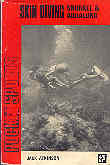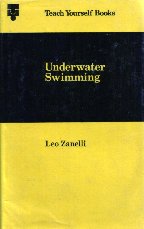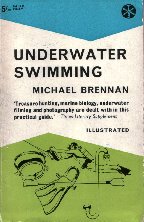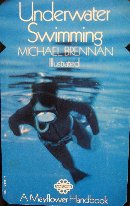| CLASSIC DIVE BOOKS
Britain - Recreational diving.
|
See author KENDALL
McDONALD
|
HOMEPAGE |
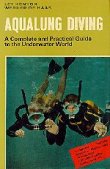 |
AQUALUNG DIVING
A Complete and Practical Guide to the Underwater World Ley Kenyon and Werner de Haas. First published under the title Tauch Mit by Albert Muller Verlag, AG, Zurich, 1959. Revised edition 1966. First published in England by George Allen ? Unwin Ltd, 1970. Hardcover, dustjacket, 348 pages, 120 drawings and 28 mono photographs. Covers the usual basic training, physiology and medicine; chapters on underwater photography, cinematography, underwater archaeoogy, fish and other inhabitants of the sea, diving clubs. [ps] |
|||
| B.S.A.C. MANUAL
See separate page for British Sub-Aqua Club Manual. |
||||
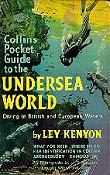 |
COLLINS POCKET GUIDE
TO THE UNDERWATER WORLD
Diving in British and European Waters. Ley Kenyon. Published in 1956, Collins, London. Hardcover, dust jacket, 256 pages, many mono plates throughout. The author is a most experienced British diver who has worked with Cousteau. Of all the British diving books, this one is perhaps the best in that it covers a great deal of material particularly on underwater photography, marine life, and archaeology - but surprisingly short on physics and physiology. The photographs, particularly of equipment, are interesting. An importaant contemporary work and still a great read. Of high historic interest. [ps] |
|||
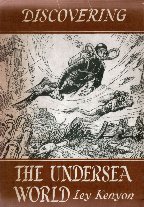 |
DISCOVERING THE UNDERSEA WORLD.
Lee Kenyon. Published by the University of London Press in 1961 Hardcover with dust jacket and 144 printed pages. Dimensions 20mm tall by 14mm wide. Contains 14 monochrome photographs and numerous drawings done by the author. Part 1 has details of a Mediterranean expedition, split into 8 parts with sections such as "The Sunken Harbour", "The Fish Hunt", "Wrecks Ancient and Modern" and "Deep Dive". Part 2 is a “Reference Section” covering subjects such as “Diving Today”, “Why Does Man Explore the Sea”, “Modern Diving”, and the “History of Diving”. The book concludes with a section entitled “Things to Do” like joining a club (the British Sub-Aqua Club) and it also gives a large list of possible books to read as well as help understanding "diving terms". Throughout, the whole book has illustrations done by the author himself and they are to a very high standard. The book is almost worth owning just for them. [pt] |
|||
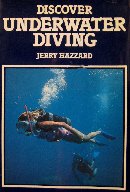 |
DISCOVER UNDERWATER DIVING
Jerry Hazzard Ward Lock Limited, London, 1979. Softcover, 120 pages, mono photos, diagrams, sketches, tables, appenicies, no index. Another 'how to dive' instructional books from the British, one of many produced in the 1960s and seventies. The six chpters: Physics and physiology; Diving equipment; Learning to snorkel dive; Learning to use the aqualung; Some additional skills; Where to dive;what to do. Jerry Hazzard wrote an edition of the BSAC manual - this book covers the basics as expected. A useful book in its time no doubt but as a collectors item, it has nothing to recommend it. |
|||
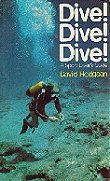 |
DIVE! DIVE! DIVE!.
A Sport Diver's Guide. David Hodgson. First published in Great Britain, 1975, William Luscombe Publisher Limited, London A bit of this and a bit off that - with pathetic photographs (a diver returning to the surface surrounded by bubbles!!!!). The first section covers the usual equipment and techniques; section two shows us what we can ddo under the sea - archaeology, photography - and a gazette of major diving locations - the three pages on Australia are amusing to say the least; section three tells of the sea and ‘the challengee'. Perhaps of interst in its day but it adds little knowledge today. [pjs] |
|||
| DIVERS AND DIVING
Reg Valentine. Blandford Press Ltd. Poole, Dorset, UK. 1981. ISBN 0 7137 0855 7 (hardcover); 0 7137 1128 0 (paper). 167 pages, colour plates, index, bibliography. Chapters: The Earliest Divers, The Autonomous Diver and Frogman, Growth of a New Sport, 20th Century Scientific, Police and Military Divers, Commrcial Diving, The Future. Certainly not your run-of-the-mile dive instruction book - more a history, and a forecast. Very interesting. British based of course. [pjs] |
||||
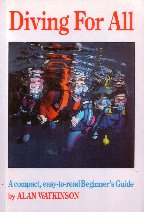 |
DIVING FOR ALL
Subtitle: A Compact, Easy to Read Beginner’s Guide Alan Watkinson Forward written by: HRH Prince Charles – The Prince of Wales. Cover Photo by Mike Portelly. Published by: Underwater World Publications, London, UK in 1986. Illustrated card covers; 95 printed pages. Dimensions: 21 cms tall by 14 cms wide “Diving For All” was written for people who are thinking of learning to dive and for a reference guide to those who can dive already. Divided into 5 parts: “Introduction”, “First Things First”, “Preparing for the Adventure”, “Sense and Safety” and “The Great Adventure”. Very well illustrated throughout with monochrome drawings and photographs. [pt] |
|||
| EXPLORING UNDER THE SEA
J. Gordon Cook Abelard-Schuman, London, 1964 Hardback Book with 160 printed pages, containing 16 b/w photographs and 19 line drawings. Dimensions: 22.5 cms tall by 14 cms wide. The book deals with the history of underwater exploration from early times to the 1960’s and also looks at what is seen to be the future underwater. It also covers subjects from the diving bell to hard hat, scuba to atmospheric suits plus the development of the submarine. [pt]
|
||||
| GUIDE TO UNDERWATER HUNTING
Simon Codrington. Adlard Coles, London, 1954. |
||||

.  |
KNOW THE GAME - UNDERWATER SWIMMING
George F Brookes; Illustrated by: R B Matkin Published by: Educational Productions Ltd, UK in 1962; In collaboration with the British Sub-Aqua Club. Printed card covers with 40 printed pages. Dimensions: 13.5 cms tall by 20.5 cms wide. This book was issued as one of the “Know The Game” series of books. It covers an “underwater swimming” course in a very simplistic way with diagrams very reminiscent to the current British Sub-Aqua Club diving manual of the time – George Brookes (the author) did co-write the first BS-AC diving manual and have some input into subsequent issues. The book takes the reader through snorkel training, aqualung diving and explains all the associated equipment and possible dangers. It goes on to say what to do after reading the book which inevitably was to join the BS-AC! The book is extremely well illustrated throughout with coloured and line drawings. Acknowledgement is also given to Draeger Normalair Limited in the preparation of the book, consequently, there is a large Normalair advert inside the front page and several of the drawings show the divers drawn wearing the equipment. Over the years, the book was updated with a fine edition in 1995. (See below). There was (and are) many other subjects in the “Know the Game” series including Angling, Camping, Judo, Model Making, Show jumping and Wrestling to name but a few. I have counted over 60 listed on the inside of the back page. KNOW THE GAME - SCUBA DIVING
|
|||
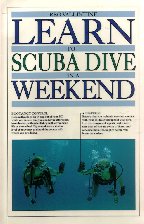 |
LEARN TO DIVE IN A WEEKEND
Reg Vallintine Published by: Dorling and Kindersley, London UK in 1996. (First published in hard back in 1993). Illustrated card covers with 96 printed pages. Dimensions: 21.5 cms tall by 14 cms wide Quite a claim to learn to scuba dive in a weekend but this is one of a series of books published by Dorling and Kindersley in the “Learn in a Weekend” series. The book’s claim is that with an “expert coach” you can learn a sport or hobby in the shortest possible time! The book is spit down as though it is a weekends course but there is a bit of cheating as there is a third section called “After the weekend”! The book is split into three sections: “Preparing for the Weekend”, “The weekend Course” and “After the Weekend”. The first section (prior to the course” familiarises the reader with theory, equipment and signals leaving the “weekend” free for all practical work. The second section is split into the 2 day “weekend” while the third section concentrates on improving the skill base. The book is extremely well illustrated with countless colour diagrams and photographs as you would expect from this publisher and is actually a good “aide memoir”. [pt] PS comment: This book caqused some interesting and not complimentary comment when it was dumped on the Austraalian mareket. I cannot remember whewn this was, but the paperback (as reviewed) was the edition and of course some dive shops affiliated, as they all are, with a bona-fide dive training association, saw it as, shall we say, a bit of a problem. If it encouraged anyone to take up ediving then all the better, but if it was used as a self-taught guide, then, like so many other 'learn to dive books', there could be a problem. |
|||
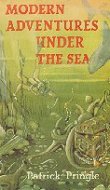 |
MODERN ADVENTURES UNDER THE SEA.
Patrick Pringle. First published in Great Britain 1959, George G. Harrap ? Co. Ltd. Hardcover, no dustjacket my copy (and pribably not at all as boards are embossed), 240 pages, several scattered mono plates. Pringle is an author (of several books) rather than a diver, although he may well have been the latter also. (Does this make sense?). This is more a history book - on the underwater world - covering a number of chapters on individual pioneers - such as Williamson, Wookey (bbet you have never heard of him), Dumas, Boutan and many othrs. He writes of standard dress, open and closed circuits, human torpedoes, ‘war under the waves'. An excellent read, comparable to the recently released Stars Under The Sea. [ps] |
|||
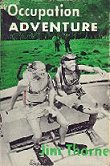 |
While producing two successful underwater films, the author provided his own dramatic highspots by riding a nine-foot shark and a 500 lb. sea turtle. He has speared a barracuda and studied its reactions at close range, explored an undersea passage with an unknown point-of-no-return, been trapped on a river bottom with his air supply exhausted and demonstrated an experimental explosive.On his way to the South Pole, he underwent a harrowing jungle survival test with The Royal New Zealand Air Force. In the Antarctic he made a historic dive under the ice in spite of the inconceivable cold,the darkness and threat of killer whales. |
|||
| OF HIDDEN DEPTHS
A. Windsor-Richards John Gifford, London, 1966. First Edition. Green cloth, hardcover, dustjacket. 5" x 7.5". No further information. |
||||
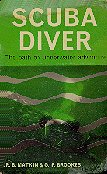 |
SCUBA DIVER
The Path to Underwater Adventure R.B. Matkin and G.F. Brookes. First published in 1963 by Macdonald ? Co. (Publishers) Ltd, London. Hardcover, dust jacket, 152 pages, central mono plates, and drawings. The usual equipment, technique etc, plus wreck diving, salvage and photography. A handy book in its day but of no apparent historic value. [pjs] See also below - YOUR BOOK OF UNDERWATER SWIMMING |
|||
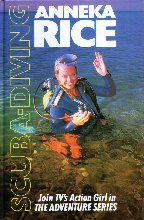 |
SCUBA DIVING
Anneka Rice Published by: Robson Books, London, UK in 1988. Printed hard cover, no dustjacket; 144 printed pages. Dimensions: 24 cms by 16 cms. This book documents the scuba training of UK’s TV presenter Anneka Rice, initially in sheltered water and then in the Red Sea on the dive boat “Lady Jenny V” for all the open water work. The training that was done with Reg Vallintine was filmed and a TV program was also made. The book is written in the form of a diary, documenting everything done each day and is very well illustrated with photographs (many colour) and diagrams in the form of cartoons drawn by “Larry” the cartoonist. Anneka Rice is well known in the UK as the “Sky Runner” in a helicopter in a UK TV program called Treasure Hunt where the contestants in a studio directed her in the helicopter searching for “treasure” following different cryptic clues. [pt] PS comment: Hardly a classic, and one wonders why it was published, its purpose. Just as well she is easy on the eyes. I wonder of the publishers would do a similar book if Gordon Brown took up diving - with respect Prime Minister! Come to think of it, Gordon Ramsey should take up diving - at least he couldn't swear underwater. Don't bet on it - he'd use a full face mask and abuse the fish. |
|||
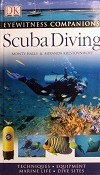 |
SCUBA DIVING - EYEWITNESS
COMPANION
Monty Halls Miranda Krestovnikoff Dorling Kindersley Publishers Ltd. London. Publish Year: 2006. Pictorial Soft Cover. ISBN: 1405312943. 343 pages. Techniques, Equipment, Marine Life And Dive Sites. |
|||
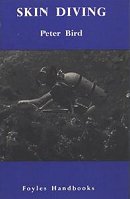 |
SKIN DIVING
Peter Bird. Published by W.? G. Foyle, Ltd., London 1962. Hardcover. 92 pages. Includes: What is Skin Diving?, Snorkelling, Aqualung Safety, Equipment Maintenance, Fishing and Photography, Clubs and Holiday. From the blurb: Skin Diving is a relatively new sport in this country. But the appeal of free swimming, in another more colourful world, a quiet, restful, almost weightless world, is making it one of our fastest-growing sports. It is a thrilling sport, with a spice of "safe" adventure, and this book shows the beginner just how to go about becoming the efficient, and complete, under-water swimmer. In addition to the step-by-step instructions, also included are details showing the range of available equipment, and the centres in this country and abroad where it can be used and where expert tuition can be received. [pjs] |
|||

|
SKIN DIVING AND EXPLORING UNDERWATER
John Sweeney. First published in 1956, by Frederick Muller Ltd, London. Hardcover, dust jacket, 160 pages, small format, several mono prints throughout. The book is dedicate 'To Happy-Bottom' for which the mind boggles. It would be nice to know just who Mr Sweeney is, but we denied that privilege. Although the book covers the rudimentss of diver training, it appears to be more of a personal account of diving, with technique thrown in. Marginally interesting. [pjs] THE HOW-TO BOOK OF SKIN DIVING AND EXPLORING
UNDERWATER
Would this be the US edition perhaps? |
|||
 |
SKIN DIVING AND SNORKELLING
Published by: A ? C Black Ltd, London, UK in 1976 Illustrated hard cover; 96 printed pages. Dimensions: 21 cms tall by 13 cms wide. Originally published in the USA in 1973 as Sports Illustrated Skin Diving and Snorkelling by Barry Allen but this edition has been edited and updated for the UK by George Cherry. The book is divided into 9 sections and each is sub-divided into individual subjects. It isn’t meant as a training manual as such but more as an aide to the trainee diver. Section headings are: “The Sport”, “Where to Start”, “Pre-Training Programme”, “Basic Gear”, “Skin-Diver Skills”, “Surface Skills”, “Putting it All Together”, “Open-Water Skin Diving” and “Useful Information”. Extremely well illustrated with quality shaded line drawings and several monochrome photographs. [pt]
|
|||
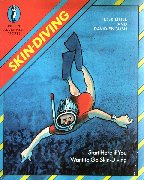 |
SKIN-DIVING - Start Here if You
Want to go Skin-Diving
Peter Little and David English Published by Puffin Books, Penguin Books, Harmondsworth, UK in 1981. Printed card covers with 62 pages (not numbered). Dimensions: 19 cms by 15.5 cms. I’m not sure where this simple guide to “skin diving” is aimed as it claims to take the reader through snorkelling to the “sophisticated equipment that highly trained divers use”. Quite a fun little book to have but it is hardly a definitive manual or workbook. Throughout, the book is illustrated with na?ve “cartoon type” drawings, all similar in style to the one on the cover. I would have thought it should have been aimed at juveniles wishing to learn to dive and get an “overview” of the sport but with me the jury is still out. [pt] PS comment: Yes, it was released for juveniles. It encouraged formal diver training and membership of the BSAC as it should, and was not published as a 'how-to' guide as such. When Penguin were about to release the book in Australia they had enough sense to realise that some of the advice was not relevant, an an edited version for Australia was required. See also the Australian edition. |
|||
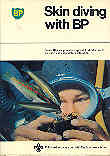 |
SKINDIVING WITH BP
James Gleeson. Publihed by Kenneth Mason for the BP Retail Market Division of Shell-Max and BP Ltd, in conjunction with the Scout Association.1972. Hardcover, 72 pages, mono prints and drawings. Looks like a handy book for these early ays of sport diving with nine chapters covering the usually expected subjects. [ps] |
|||
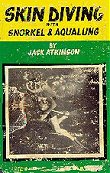 |
|
|||
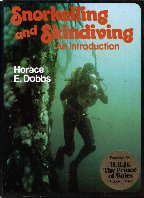 |
SNORKELLING AND SKINDIVING
- An Introduction.
Horace E Dobbs. Forward by: HRH The Prince of Wales (President BS-AC) Published by: Oxford Illustrated Press, Oxford, UK in 1976. Printed hard covers; 96 printed pages. Dimensions: 25.5 tall cms by 19 cms wide. The book is meant as an introduction to the beginner to both snorkelling and “skin diving”. The author gives his step by step approach to learning to snorkel and dive. It is divided into 9 chapters: “The First Skin-divers”, “Snorkelling”, “Snorkelling in the Sea”, “Aqualung Diving”, “Underwater Photography”, “Treasure Hunting and Underwater Archaeology”, “The Underwater Naturalist”, “Diving Holidays” and “Turning Professional”. Lots of examples of early scuba equipment including twin hose as well as single hose regulators and “Frenzy” type life jackets. Well illustrated with monochrome photographs, all taken by the author himself. [pt]
|
|||
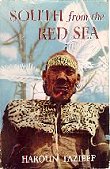 |
SOUTH FROM THE RED SEA
Haroun Tazieff. Translated by Naomi Lewis. Edition viewed is The Travel Book Club, London, no date - probably 1950s. Hardcover, dust jacket, 212 pages, mono plates in four sections. The author was with Cousteau when he explored the Red Sea, on the Calypso. [pjs] |
|||
| SUB-AQUA ILLUSTRATED DICTIONARY
Leo Zanelli an George Skuse. |
||||
| SUBAQUA SWIMMING. Leo Zanelli. See Teach Yourself Underwater Swimming, below. | ||||
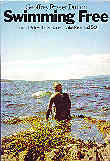 |
SWIMMING FREE
On and Below the Surface of Lake, River and Sea. Geoffrey Fraser Dutton. William Heinemann Ltd, London. 1972. Hardcover, dustjacket, 154 pages, mono prints and a few colour. I have no idea what this book is about - and here it is before me. The fly reads: 'What can we do with ourselves', asks the author,' what is there to do, once we have gone to the botherof learning to swim?. In this book he tell us. Well, thats gratifying. Who is this guy? Well, he is a doctor, and lives in th Highlands with wife and three children and is well known in Scottish mountaineering circles ... and 'discovers the best communion of mind and matter when floating far out on the sun-smacked waves...' There is mention of diving. |
|||
 |
TEACH YOURSELF UNDERWATER
SWIMMING
Leo Zanelli.
|
|||
| THE ART OF THE AQUALUNG
How to Swim and Explore Underwater. Robert Gruss. Translated by Richard Garnett from "Manuel de l'homme sans poids" MacGibbon and Kee, New York. First published in France 1953 First published in England 1955 Printed in England by Wyman and Sons, Ltd. London, Fakenham and Reading. (Added details, thankyou RG). |
||||
| THE COMPLETE UNDERWATER DIVING MANUAL
David McKay. David McKay Publishing - 1977 . Hardcover. This text contrains instruction, scuba training, diving psychology, hydrostatic pressure and much more concerning underwater diving. Not sure of this is British or American. |
||||
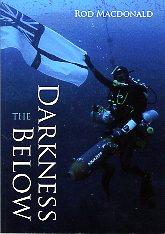 |
THE DARKNESS BELOW
Rod MacDonald. Whittles Publishing, Scotland, U.K. 2011. Softcover, 208 pages, mono photographs and colour plates. No index. From the back cover blurb: The diving world has waited since 2005 for the sequel to Rod's best-selling Into the Abyss; and here it is at last. Dive with Rod as he progresses from Deep Air to Trimix - and then onto Rebreathers. Experience exploring virgin shipwrecks at the very edge of deep mixed gas diving - share in the adventure, danger and laughter along the way. Be there. Told in intimate detail with a beguiling sense of self-deprecating humour, he recounts epic dives on some of the most fabulous shipwrecks around the world. A daring expedition into the heart of the feared Corryvreckan whirlpool, the third largest in the world, keeps the reader engrossed. Terrifying first explorations of virgin shipwrecks far offshore, lost in time and enshrouded in darkness in the silent depths, cram the pages. Chapters include diving on the wrecks of the SS Cushendall, Hampshire, German destroyer T6,the liner Remuera, SS Kildare, SS Bretagne, HMS Prince of Wales, HMS Repulse, SS Greenawn, SS Creemuir and others. A well rpoduced and well written diving biography by a top UK diver. [pjs] |
|||
|
DIVER AND UNDERWATER SPORTSMAN |
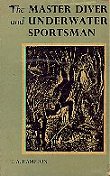 . . 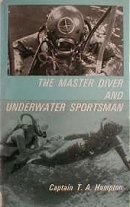 . . 
THE MASTER DIVER AND UNDERWATER SPORTSMAN
THE MASTER DIVER AND UNDERWATER SPORTSMAN
|
|||
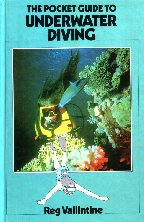 |
THE POCKET GUIDE TO UNDERWATER DIVING
Reg Vallintine Published by: Bell and Hyman, London, UK in 1985. (One from a series called “Pocket Guide to Sport”) Printed hard covers; 94 printed pages. Dimensions: 19.5 cms tall by 13.5 cms wide. Although written as a mini guide to learning to dive the book is high in facts and content. Like so much written by this author, it is biased to the UK diving system called the British Sub-Aqua Club (BS-AC), in fact the traning notes from the organisation were used as the basis (written in acknowledgements). It is divided into 6 parts, progressing through diver training: “Equipment”, “Signals”, “Hazards and How to Overcome Them”, “The First Dives”, “Holiday Diving” and finally “Lifesaving and Rescue”. Extremely well illustrated with colour photographs and coloured drawing, very much in the style of the BS-AC diving manual. This is one os several books written in “Pocket Guides to Sport” series, others are cycling, dingy sailing, riding and windsurfing. [pt] |
|||
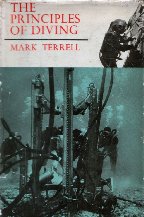 |
THE PRINCIPLES OF DIVING
Mark Terrell. First published 1965. Stanley Paul ? Co. Ltd, London et al. Hardcover, no dustjacket on review copy, 240 pages, 27 photographs and drawings, 7 tables . The usual techniques, equipment, physiology; self-contained equipment, submarine medicine, underwater fishing, seamanship, underwater work, future development, et al. Chapters: The Sea as an enviorment, Safety and Communications, Diving without apparatus, Diving using Surface Air supply, Deep diving and self-contained equipment, Submarine Medicine, Underwater fishing, Seamanship and surface navigation, Underwater navigation, searching and surveying, Underwater work, Future developments. Would ave beeen a most useful book in its day, with comprehensive detail on all aspects of basic diving theory and medicine, as well as 'underwater fishing', seamanship and surface navigation, underwater navigation, underwater work, and an interesting chapter on 'Future Developments'where the author writes of being (at the time), on "... the verge of a great advance in the teachniques that will enable mankind to move with ease and cerrtainty in the underwater environment". He mentions 'composite diving equipment', where the 'canister gas supply' is intergrated with the diving suit made of 'a tough skin' - which is esentialy a dry suit, although we dont have a integrted suit and air supply as such for sport diving. Yet we do have rigid articulated suits, or Atmospheric Diving Suit which were around in the sixties anyway, for commecial use. (Without a dusjacket, there is no indication as to the authority of Mark Terrell the author but I guess is he is navy trained.) [cd][pt-dj] USA Edition: A. S. Barnes, South Brunswick, NJ. 1967. First American Edition. |
|||
| THE SPEARFISHERMAN'S HANDBOOK
David Way, Robert Hale, London 1981. Hardcover, dustjacket, 8vo - over 7" - 9" tall; 160pp, index, b?w illus, plates. |
||||
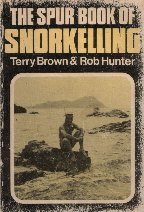 |
THE SPUR BOOK OF SNORKELLING
Terry Brown and Rob Hunter Published by: Spur Books Limited, Bourne End, UK in 1976. Cardback with illustrated covers and 60 printed pages. Dimensions: 18 cms tall by 12.5 cms wide. Written as one of a series of “Spur Venture Guides”, this small book is a really good small guide to learning and actually doing snorkelling. It is illustrated throughout with line many excellent line drawings which do not detract from the course in any way. The author does acknowledge the help given by Jerry Hazzard, the then director of coaching at the British Sub-Aqua Club (BS-AC). Other books in the series are the Spur Book of: “Map and Compass”, “Knots, Bends and Hitches”, “Sailing”, “Camping”, “Survival and Rescue”, “Outdoor First Aid”, and “Weather Lore”. [pt] |
|||
| THE UNDERWATER HANDBOOK
Edmund Bourke. Frederick Muller Ltd, London. 1963. Hardcover, dustjacket, 260 pages, mono illustrations, glossary, bibliographydeco tbles, index. Dimensions 20.5 cms tall by 13.5 cms wide Details taken from the dustjacket: “Skin Diving has experienced a remarkable rise in popularity in recent years and thousands of new adherents to this exciting sport appear every summer. But enjoyable though it is, underwater activity is not to be taken lightly; it has its dangers as well as its pleasures and even the most cautious are not always aware of the effects of air embolism and nitrogen narcosis and how to combat the more uncongenial ocean inhabitants. Here is the work which will tell you everything you wish to know: apart from the invaluable, authoritative, chapter on the dangers of the sport there is advice on selecting and using equipment, techniques and training, underwater photography and even treasure hunting. There are also chapters on undersea life and the history of the subject and a glossary which could well become a standard work among underwater enthusiasts. Both the inexperienced and the advanced sub-aqua man- and woman will fine this a pleasantly informative, indispensable work.” The book is divided into 10 chapters : “Underwater History”, “Preservation of Underwater Life”, “Equipment”, “Training and Techniques”, “The Underwater World”, “Danger Underwater”, “The World’s Best Diving Areas”, “Underwater Photography”, “Underwater Hunting” and “ The Future”. The book is illustrated with 17 monochrome photographs and other diagrams. This is a good read, even after forty years. The history of diving is interesting, and 'The Wirld's best Diving Areas' is open to debate. Would have been popular book in its day. [pjs],[pt] |
||||
| THE UNDERWATER WORLD
The Complete Guide to all phases of safe underwater fun in oceans, rivers and laakes. John Tassos. First printing March 1959, Prentice-Hall, Inc. New Jersey. Hardcover, dust jacket, 242 pages, two sections of mono plates. The book goes beyond the basics of diving instruction and looks at ‘a new approach to angling' (for example), underwater photography, ‘just looking', wreck exploration, shell collecting - ie, things to do underwater. Not of particular historic value. |
||||
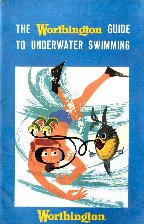 |
THE WORTHINGTON GUIDE TO UNDERWATER SWIMMING
Capt. Trevor Hampton Published by: Worthington Breweries, Burton Upon Trent, UK in 1960’s. (Exact date unknown) Printed card covers; 24 printed pages (un-numbered). Dimensions: 22 cms tall by 14 cms wide. This delightful little booklet was issued by Worthington breweries in Burton Upon Trent in the UK in the 1960’s and written by Capt. Trevor Hampton (author of “The Master Diver and Underwater Sportsman”). As you would expect, this is not a diving manual but is a good over-view for a potential diver. It is illustrated throughout with diagrams like seen on the cover and several photographs in colour and monochrome by noted photographers of the time. Not in chapters, this is divided into small sections: “A New World to Explore”, “A New Sport to Enjoy”, “Skin Diving”, “Free Diving”, “Submarine Pressure”, “Decompression”, “Deep Diving”, “Diving Locations”, “The Cost”, “Important Notes”, “The Lifejacket”, Air Failure”, “Free Ascent”, “Protective Clothing”, “First Aid”, “Air Supply” and “The Law”. One thing that really amuses me comes under “Important Notes”, “Training” and I quote: “There are a number of clubs and groups in Great Britain, twelve of them being in association with the British Underwater Centre at Dartmouth, Devon, forming the Association of British Underwater Clubs. All these clubs believe in the principle of individual self-reliance, which has been developed to achieve maximum safety in our thicker tidal waters. They undertake that their members will always use a CO2 life-jacket, and make use of a safety boat when diving in open tidal waters. There are other clubs outside the Association, some of which practise the British method, and some, like the British Sub Aqua Club, that sponsor the ‘buddy diving’ technique, an import from the Mediterranean, and practised, in theory at least, in the clearer ‘playboy’ waters of the world.” Can anyone define what are 'playboy waters'? I guess Trevor Hampton had issues with the BS-AC? [pt] Phil adds: This is a cracker of a little book, published by a brewery. On the cover, you will see the diver's tanks are cans of Worthington beer, maybe a reflection of the diving habits when not underwater? PS comment: If the tanks were Fosters, or Vic Bitter, this would be an ideal Aussie rig. The 'playboy world' I think is innocuous enough as it no dobt refers to the wealthy tourist stretch of the Riviera. |
|||
 |
THIS IS SPORT-DIVING
TECHNIQUE, A Handbook for Beginners.
Duilio Marcante First published 1977 by United Nautical Publishers SA, Basle (Switzerland). British edition same year - Nautical Publishing Co, publishers, Hampshire, UK - ISBN:0245528628, in conjunction with George G. Harrap ? Co. Ltd., 1977. Hardcover, 7?" x 8", with dust jacket 144 pages. "Sport-Diving involves learning to live, work, and play in a foreign environment. This book explains, with the aid of full colour photographs and drawings, the basic techniques for underwater swimming without equipment, with snorkel gear, and with scuba. Also included are sections on how to swim correctly, use of fins and other equipment, maintenance of gear, possible medical problems and first aid. |
|||
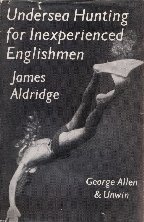 |
UNDERSEA HUNTING FOR INEXPERIENCED
ENGLISHMEN
James Aldridge Published by: George Allen ? Unwin, London in 1955. Hard blue cover with dustjacket; 124 printed pages. Dimensions: 22 cms tall by 14.5 cms wide This book is a guide of how to hunt fish very cheaply with nothing more than masic equipment and a spear gun. Divided into 13 chapter, the book not only explains equipment and methods of fish hunting but includes identification charts and fish recipes. Illustrated with 12 monochrome photographs and several line drawings. [pt] |
|||
| UNDERSEA WORLD. Ley Kenyon. 1956. See above under COLLINS POCKET GUIDE TO THE UNDERSEA WORLD | ||||
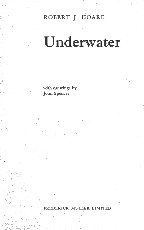 |
UNDERWATER
Robert J Hoare, Drawings by: John Spencer. Published by: Frederick Muller Ltd, London UK in 1975. Blue hard back; 69 printed pages. Dimensions: 24 cms tall by 15.5 cms wide. Dustjacket?? For such a small book, it covers an awful lot of ground. And subjects. It is divided into 9 chapters: “Down to the Depths”, “On the Ocean Floor”, “Early Divers”, “Treasure From The Sea-Bed”, “Skin Diving”, “Attack By Frogmen”, “Rescue From The Deep”, “Seven Miles Down”, “Sink the Tirpitz”. The book has no photographs but is really nicely illustrated with line drawings, excellently drawn by the illustrator, John Spencer. This has to be a school text book as each chapter closes with a “Things To Do” paragraph. For example at the end of the first chapter you are told to “Make a model bathysphere with papier mache, build your globe around a toy ball of balloon. The bathysphere used by Otis Barton was painted white to attract fish”. There are two other exercises as well after the first chapter. At the end of the “Sink The Tirpitz” chapter, the readers are asked to “Invent a secret underwater weapon of your own and make a model of it. Write an account of how it works and how it may be used”. Two more exercises exist after this chapter. [pt] |
|||
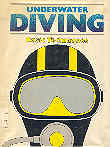 |
UNDERWATER DIVING - BASIC TECHNIQUES
Peter Dick and David Sisman Published in 1986 by Pelham Books Ltd, London. Hardcover, dustjacket, 144 oages, mono drawings, charts, glossary, index. "Underwater Diving is presented in two volume: Basic Techniqiues and Advanced Diving. This first volume introtrocuces the complete beginner to the sport and takes the novice through all the basic training up to the following standards - BSAC, SAA, PADI, CMAS. [ps] |
|||
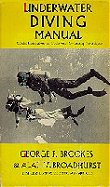 |
UNDERWATER DIVING MANUAL
Official Instructions on Underwater Swimming Techniques. George F. Brookes and Alan V. Broadhurst, First Class Divers of the British Sub-Aqua Club. First published privately under the title ‘Diving Manual' by the BSAC, 1959. This edition 1962. Hardcover, dustjacket, 240 pages, a few mono photos, drawings and charts. Obviously the main training manual for BSAC divers. Covers the usual equipment, techniques and physiology; also rescue methods, activities. I'd say there would be quite a few of these around, so its historical value as a book is limited. [ps] |
|||
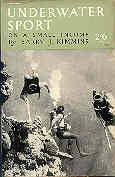 |
UNDERWATER SPORT ON A SMALL
INCOME
Barry J. Kimmins. Hutchinson, London, 1956. Paperback, 128 pages, mono prints. This is a new one to me - I had not heard of it before, which is surprising as it is an English title and Hutchinsons ? Co., have a Sydney office, so the book should have been distributed in Australia also - but, perhaps not. It is one of the first of the 'popular' amateur diving 'how-to' books - popular in the sence that it was readily available to the British divers at least. The basic equipment is as expected - twin hose regs, full face mask, small Siebe Gorman Aqualungs, rubber suits and sweaters. It centres on the activity of spearfishing as would b expected for the time, but also includes underwater photography which would have been in its infancy. A quick read shows the book as having been competently written. It would have been a most useful volume in its day. [ps] Also came out as a hardcover, exactly same details as above. It probably has a dustjacket, although I do not have one. [ps] |
|||
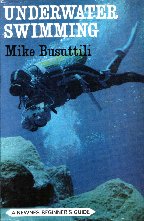 |
UNDERWATER SWIMMING
Mike Busuttili Published by: Newnes of London in 1968. Hard back, blue covers with dustjacket; 148 printed pages. Dimensions: 19 cms tall by 12.5 cms wide. This book is one in “A Newnes Beginners Guide” series and is meant as an introduction to the sport of “underwater swimming” and aimed at the absolute beginner or someone who was thinking of taking it up. It is divided into 2 parts, part 1 covering the basic training and part 2 looks at what can be done when trained. There are 8 full page monochrome photographs and many line drawings to illustrate the text. There are other books in this series for subjects as far ranging as bird watching, dingy sailing, coarse fishing, golf, sea angling, fly fishing and what we’ve all been missing for years – flower arranging! [pt]
|
|||
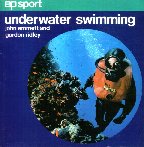 |
UNDERWATER SWIMMING
John Emmett and Gordon Ridley Published by: E P Publishing, Wakefield, UK in 1978. Printed card covers – 120 printed pages Dimensions: 20 cms tall by 19.5 cms wide. This seems to be one of a series of books published by “BP Sport”, others include sailing, rock climbing, football, cricket, etc. Possibly not as comprehensive as other contemporary dive manuals but it does cover a fair bit of ground with scuba training from the history to equipment choice and techniques of the time. It is divided into eleven discreet well illustrated sections: “History, Development and Types of Scuba Diving”, “Snorkel Diving: Introduction”, “Snorkel Diving: Techniques and Safety”, “Aqualung Diving: Introduction”, “Aqualung Diving: Techniques and Safety”, “Open Water Training”, “Decompression and Decompression Diving”, “Organising and Running a Dive”, “Joining the British Sub-Aqua Club”, “First Aid” and “Metrication”. As seen with the list of subject matter, the book is very oriented towards the British Sub-Aqua Club but it does outline details of courses from basic to highest level. The book is expremely well illustrated with many monochrome photographs and line drawings. [pt] |
|||

. |
UNDERWATER SWIMMING
Michael Brennan
|
|||
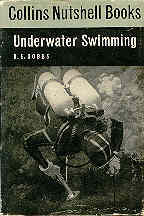 |
UNDERWATER SWIMMING.
H.E.Dobbs. A Collins Nutshell Book. William Collins Sons ? Co, London and Glasgow, 1966. Hardcover, dust jacket, 160 pages, mono prints and drawings. A concise book, obviously, covering 'Early Aquaphiles', diving physics, snorkel diving, the underwater hunter, Aqualung diving, diving expeditions, underwater photography, home-made equipment, and underwater science. [ps] |
|||
|
|
UNDERWATER SWIMMING -
AN ADVANCED HANDBOOK
Edited Leo Zanelli Approved by the British Sub-Aqua Club. Kaye and Ward Ltd, London, 1969. Hardcover, dustjacket, 128 pages, drawings, a few mono photographs, no index. Beyond a basic 'how-to-dive' book, it covers a number of interesting and 'advanced' diving chapters by a number of authors. 'gas Mixtures', by R.J. Walsingham; 'The Scuba Unit' by R.R.B.Collins; 'Drugs and Diving', by K.H.Moncad; 'The Air Supply', Chapman and Freeman; 'Underwater Work' by Mark Terrell, 'Echo Siunders' by J.C.Lawson; 'Metal Location' by L.J. Gascoyne; 'Diver Transport Vehicles' by George Cooke; 'Underwater Communication' by A.R.Parker. [cd] |
|||
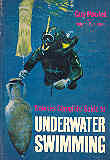 |
Newnes Complete Guide to
UNDERWATER SWIMMING Guy Poulet and Robert Barincou. First published in France under the title, 'Connaissance et Technique de la Plongee', by Editions Doneul, Paris, 1962. This edition by George Newnes Lts, London, 1964. Translater from the French by Douglas Burton. English technical adviser: Mike Busuttili. Hardcover, dustjackt, 310 pages, mono prints with some colour, charts, drawings, dive tables, translation of diving words into several other languages. Contains the usual instruction for recreational scuba, including marine life, underwater photography |
|||
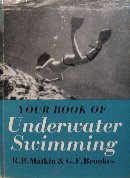 |
YOUR BOOK OF UNDERWATER SWIMMING
R.B.Matkin ? G.F.Brookes. Faber ? Faber Ltd.,London. 1966. Hardcover, laminated board covers, 86 pages, mono photographs and drawings, no index. This title was published after their 1963 book Scuba Diver', and is larger and printed on better quality, gloss paper. It is one of the "Your Book Series' of publications which include everything from Acting to Wild Flowers - and Space Travel - a series dedicated to the young reader. How this book differs from 'Scuba Diver' I cannot be bothered to find out, but it appears to be your usual 'how to dive' book, with the usual chapters on equipment, technique, and physiology - plus 'Dangers in Diving'; 'When and Where to Dive (UK of course); Spearfishing and Photography; Life Saving and "What Next in Diving". The later chapter, of just two pages, mentions living under the sea in the future, .... " Small towns and even large cities may one day be constructed on the sea-bed. A series of igloo-type buildings able to withstand the great pressures of the water could be connected by roads laid in strong metal tubes. Through air-locks, people in aqualungs will be able to leave these cities to explore the seas, farm the sea-bed, collect and process plankton. They may even heard large mammals like the whale into pens and extract from them the milk they produce, just as farmers milk their cows". Rest assured that the dairy farmers that surround my country town have not rushed to take up 'aqualung' diving in the anticaption of this event! But the final coment from the authors is well worth repeating: "The undersea world hs beauty, mystery and a store of wealth for those who seek a new spirit of adventure".How true. [cd] |
|||
| YOUR GUIDE TO UNDERWATER
ADVENTURE
Peter Small. Lutterworth Press, London, 1957. Hard Cover and dust jacket with 119 printed pages. Dimensions 20.0 cms tall by 13.0 cms wide. Contains 8 monochrome plates and 11 diagrams The book is aimed at the beginner going into detail of equipment and techniques. He has tried to use the book as a guide to training and the do’s nd don’t when choosing diving equipment at the time – he has even given a guide to prices. The book is divided into two parts and each part being sub-divided again as follows: Part 1 – First Steps 1 Setting Up; 2 First Steps; 3 Down to the Sea; Part 2 – Further Exploration; 4 Sea Pressures and You; 5 Tools for the Job; 6 Now You’re a Fish; 7 What to Do (Places of diving interest in the UK) Footnote: Peter Small was a professional journalist and keen amateur diver but he was more famous as the co-founder of the British Sub-Aqua Club (BS-AC) with Oscar Gugan in 1953. Tragically, Peter died in a diving accident in 1962. He was attempting a 1,000 foot bell dive with Hannes Keller off Santa Catalina Island, California, USA when he lost conciousness on descent. Even more tragedy was to strike the experiment when fellow English diver Christopher Whittaker died at a depth of 200 feet while attempting to attach pressurisation hoses. [pt] |
This CLASSIC DIVE BOOKS site is sponsored by:
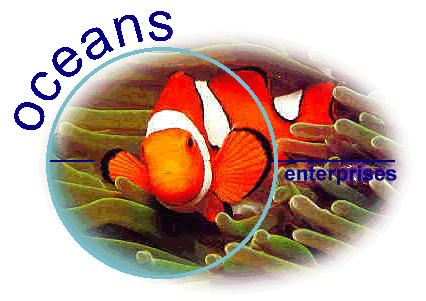 |
For
OCEANS ENTERPRISES homepage, link on graphic. |
Publishers and Distributors 303 Commercial Road, Yarram, Vic 3971, Australia Phone (03) 5182 5108 International 61 3 5182 5108 Email: peter@oceans.com.au |
 |
Admin: All links made.
